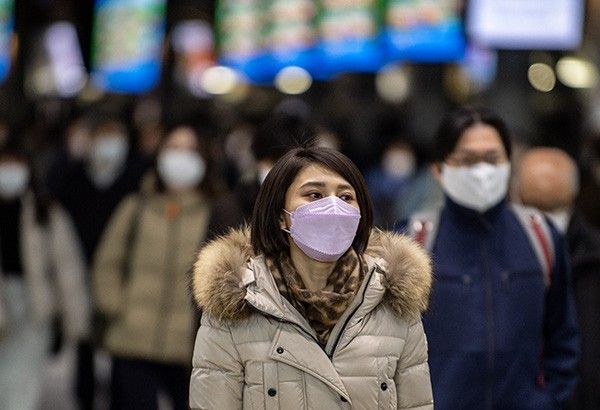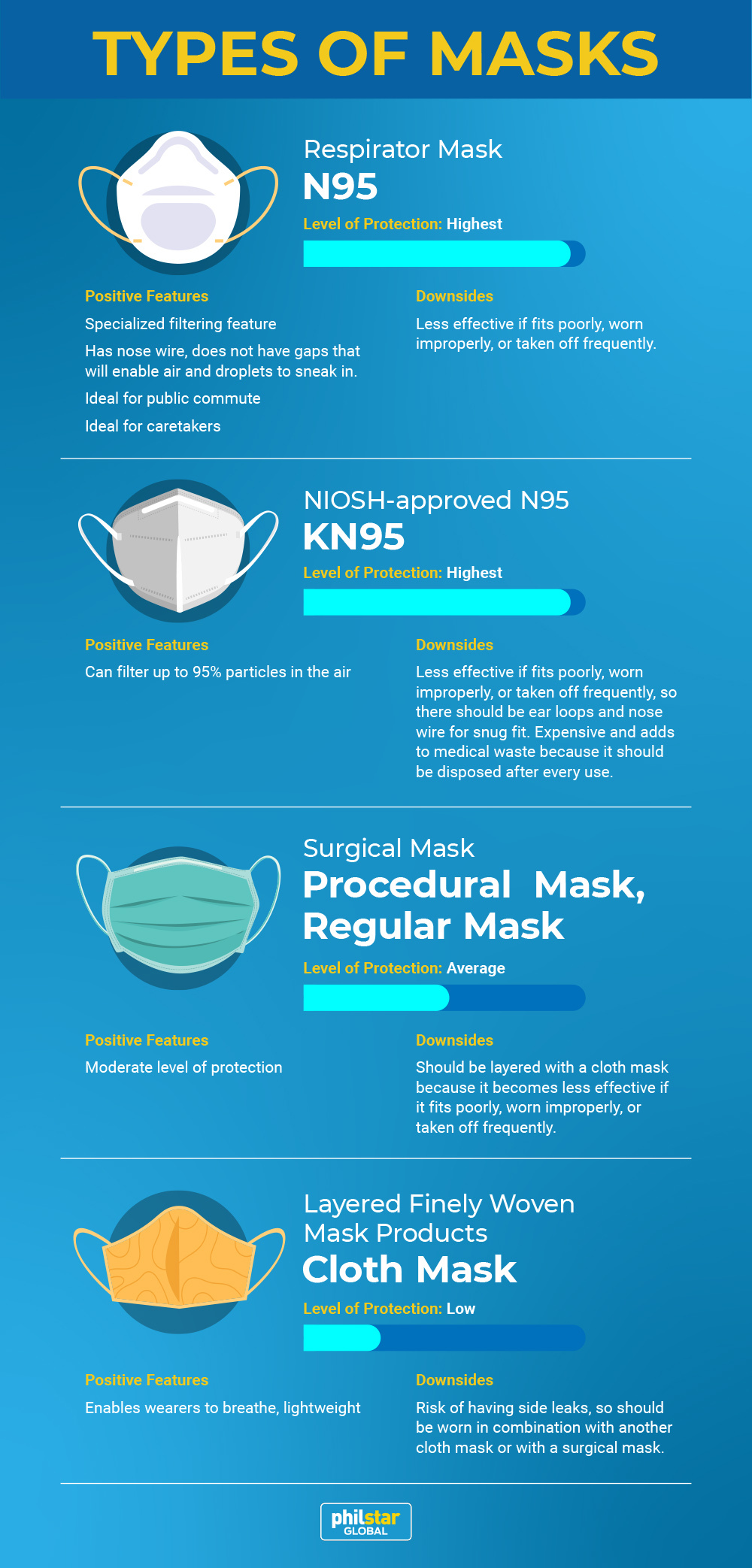LIST: What masks to wear to combat COVID-19 variants

MANILA, Philippines — Amid talks of using N95 masks in light of the surge of Omicron cases all over the world, masking up is still among the best ways to protect oneself from COVID-19 variants.
Health agencies such as the United States' Centers for Disease Control and Prevention (CDC), the World Health Organization (WHO), and the Philippines' Department of Health have been regularly issuing mask guidelines since the start of the pandemic two years ago.
Here is a brief summary of these agencies' issued guidelines:
N95 offers the highest level of protection
On its latest bulletin dated January 14, CDC clearly defined the different types of masks and respirators and how these work to protect the wearer.
Masks, in general, contain droplets and particles that the wearer breathe, cough or sneeze out. Respirators also do these function as well as protect the wearer by filtering the air. They are made to snugly fit the face to filter out particles, including the SARS-COV2 virus that causes COVID-19.
"Masks and respirators (i.e., specialized filtering masks such as 'N95s') can provide different levels of protection depending on the type of mask and how they are used:
- Loosely woven cloth products provide the least protection,
- layered finely woven products offer more protection,
- well-fitting disposable surgical masks and KN95s offer even more protection,
- and well-fitting NIOSH-approved respirators (including N95s) offer the highest level of protection," the bulletin read.
The National Institute for Occupational Safety and Health (NIOSH) is the US non-regulatory federal agency responsible for research and issuing recommendations for the prevention of work-related injury and illness.
NIOSH uploads weekly updates of its approved N95 respirators through this link.
What makes a well-fitting mask
CDC has always stressed the use of a well-fitting mask, which it defines as a tool that features a nose wire, fits snugly over nose, mouth and chin, and does not have gaps that will enable air and droplets to sneak in. In addition, a mask fitter or brace over a surgical mask is recommended for those with facial hair.
Which is better, a respirator or regular mask?
"A respirator has better filtration, and if worn properly, the whole time it is in use, can provide a higher level of protection than a cloth or procedural (surgical) mask," the bulletin noted. "A mask or respirator will be less effective if it fits poorly or if you wear it improperly or take it off frequently."
It added that using respirator may be considered for specific situations and by people who need greater protection.
People who care for the COVID-19 positive, as well as those that are elderly and immunocompromised, are advised to mask up with authentic respirators. People whose jobs leave them vulnerable to the disease such as public utility vehicle drivers and grocery workers are also advised to do the same. More protection is also needed for those whose vaccination are yet to be completed.
The use of respirators is also seen ideal in public places when physical distancing cannot be observed as well as when riding on planes, buses, trains, or other forms of public transportation, especially if it is for a long period of time.
How to spot an authentic, NIOSH-approved N95
Another type of mask that is used is KN95. These are respirators commonly made and used in China. CDC said that when these meet the right requirements and are proven to be authentic, these masks can filter up to 95% particles in the air.
The agency also released an infographic to determine authentic N95 respirator masks. It also included a separate list of guidelines to spot an authentic KN95.
Some of the key features of an authentic, NIOSH-approved N95 mask include:
- the NIOSH logo,
- manufacture's name,
- TC approval number,
- NIOSH filter series that is composed of an alpha-numerical rating followed by filter efficiency level (e.g. N95, N99),
- model number,
- lot number
- and date of manufacture.
WHO espouses a 'Do It All' approach
The United Nations health agency has been observing the "Do It All" approach that includes wearing of "well-fitted masks."
WHO recommends three types of masks. These include:
- reusable non-medical masks that comply with the ASTM F3502 standard or CEN Working Agreement 17553, or a non-medical mask meeting WHO essential parameters;
- disposable medical masks that comply with medical mask standards EN 14683 Type I, ASTM F2100 Level 1, YY/T 0969, YY 0469 (or equivalent); and
- other types of well-fitting non-medical masks, including homemade multi-layered masks are an acceptable option, when other options are not available.
ASTM or the American Society for Testing and Materials developed the Barrier Face Covering standard (F3502-21) with NIOSH that established a set of uniform testing methods and performance criteria. The requirements include filtration efficiency and air flow. These should labeled accordingly and are tested by an accredited laboratory.
CEN, on the other hand, is the European Committee for Standardization. It released the guidance for coverings titled, "Community face coverings – Guide to minimum requirements, methods of testing and use" in 2020.
"A respirator or a medical mask should be worn by to caregivers at any setting where care is provided to patients with suspected or confirmed COVID-19, including home care, long-term care facilities and community care settings," the WHO guideline stated.
DOH recommends medical-grade masks over cloth masks
The Philippines' health department reiterated foregoing cloth masks especially among the vulnerable population such as immunocompromised in its latest update. Wearing of double-cloth masks, however, is encouraged when it is the only alternative available.
"Medical grade masks are recommended for healthcare workers, vulnerable populations (elderly, with comorbidities, immunocompromised), all persons with any symptoms suggestive of COVID-19 (even if mild), and the general population in high transmission risk settings based on their community risk or nature of work," it said.
As of January 19, the DOH reported 492 new cases of Omicron, 332 of which are local cases. It brings a total of 535 confirmed Omicron cases in the Philippines. Delta cases are at 8, 612. The Philippines logged at total of 28, 471 new COVID-19 cases on January 18.
"All persons with any symptoms suggestive of COVID-19, even if mild, as well as vulnerable populations (elderly, with comorbidities, immunocompromised), shall wear a medical-grade mask. Use of cloth face masks is not recommended in view of rising cases of COVID-19 in the country. However, if a medical grade mask or surgical mask is unavailable, wearing of two cloth masks could be an alternative."




















